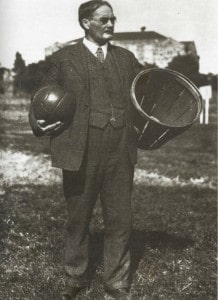Engineering and basketball go together as we begin the Sweet 16 games in the NCAA tournament, but just how has engineering affected the game?
History

In 1891, at Springfield College, Massachusetts, Dr. James Naismith, a thirty-year old physical education instructor, was encouraged to create an indoor, winter “athletic distraction.” Using two vegetable baskets, a soccer ball, nine men per team, and a ladder to retrieve the ball from the basket, the game of basketball came into existence. He never entertained the notion of patenting his new game because it was for recreational fun. “Basketball is just a game to play. It doesn’t need a coach… you don’t coach basketball, you just play it.” Despite his comment, in 1900 he became the basketball coach for the Jayhawks at the University of Kansas.
Between 1892 and 1894, formal rules were devised, an inflated leather, albeit occasionally lopsided, ball was invented, backboards were designed so fans could not reach over and deflect the shots, and iron hoops and hammock-style enclosed baskets were introduced to the game. It was another decade before open-ended nets were used. On January 18, 1896, the first “experimental” college basketball game was played between the University of Iowa and the University of Chicago. The final score: Chicago 15, Iowa 12.
The Ball
In the 1930s a flurry of patents were filed suggesting that the game was becoming a viably commercial sport. However, the ball is considered the most important piece of equipment. The original basketball was patented in 1929 (see U.S. Patent 1,718,305). It was made of leather on the outside and butyl rubber on the inside. Zinc and cooper plates imprinted the label onto the ball. Today, the Wilson Sports Good Company is maker of the official NCA basketball, the Solution. The company’s patented composite-leather technology absorbs moisture and the pebbled-triangle design creates for better ball handling (see U.S. Patent 4,570,931).
The game of basketball continues to evolve with technology enhancements such as breakaway rims, vision replay, and performance shoes. If only Dr. Naismith could have foreseen the future of his fun “athletic distraction.”
References
The Physics of Basketball (Engineering Library QC26 .F66 2006)
Two Guys From Barnum, Iowa and How They Helped Save Basketball: A History of U.S. Patent 4,534,556 by Francis B. Francois (2008)
America’s Story from America’s Library
Top 5: Early Basketball Patents